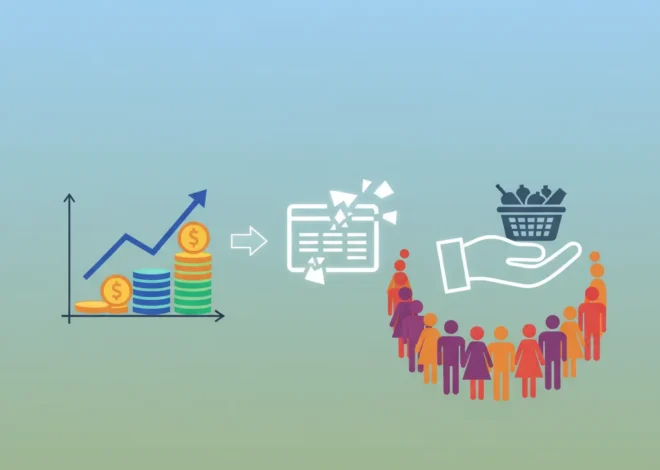
Beyond the Balance Sheet: Why a Local Supermarket is a Blueprint for the Future of Finance and Investing
A Small Shop in Hull, A Giant Leap for Economic Models
On the surface, the news is disarmingly simple: a supermarket on Hull’s Bransholme estate is set to sell cheap food, offer free meals for children, and run a community kitchen. As reported by the BBC, it’s a heartwarming local story. However, for astute investors, finance professionals, and business leaders, this is far more than a feel-good headline. It’s a real-world, functioning prototype of a powerful and disruptive force reshaping modern economics: the social enterprise. This single initiative is a powerful case study in impact investing, corporate social responsibility (CSR), and a new, more resilient form of capitalism that merits serious attention from Wall Street to Silicon Valley.
This isn’t about charity; it’s about a fundamental re-evaluation of value. While the traditional stock market chases quarterly earnings, a new class of enterprise is proving that profitability and social progress are not mutually exclusive. They are, in fact, two sides of the same coin. This Hull supermarket represents a sophisticated business model that generates financial returns alongside measurable social and economic dividends, tackling systemic issues like food insecurity and community fragmentation at their root. Understanding this model is no longer optional—it’s essential for anyone involved in the future of finance and the global economy.
Deconstructing the Social Enterprise: A New Economic Engine
What exactly separates this community supermarket from a standard grocery chain or a traditional non-profit food bank? The answer lies in its structure as a social enterprise—a hybrid model designed to blend the revenue-generating engine of a business with the mission-driven heart of a charity. These organizations are not content with simply donating a fraction of their profits; their entire operational framework is built to create positive change.
According to Social Enterprise UK, these businesses reinvest the majority of their profits back into their social or environmental mission. In the case of the Hull supermarket, every sale of “cheap food” directly funds the “free kids’ meals” and the “community kitchen.” It’s a self-sustaining ecosystem where commercial activity is the fuel for social impact. This model offers a compelling alternative to the often-unstable, donation-dependent nature of non-profits and the single-minded profit-maximization of traditional corporations.
To better understand the distinction, consider the following comparison:
| Attribute | Traditional Corporation | Social Enterprise |
|---|---|---|
| Primary Goal | Maximize shareholder profit | Achieve a specific social/environmental mission |
| Profit Distribution | Distributed to shareholders as dividends | Primarily reinvested to further the mission |
| Performance Metrics | Financial metrics (EPS, ROI, Stock Price) | Blended value: Financial sustainability + Social Impact metrics |
| Source of Capital | Stock market, traditional banking, venture capital | Impact investing, grants, traditional loans, revenue |
| Relationship to Social Issues | Often addressed through a separate CSR department | Core to the business model and operations |
This table illuminates a crucial shift in business economics. The social enterprise doesn’t view community support as an expense line item; it views it as its core product. This integrated approach creates a powerful flywheel effect: the more successful the business, the greater its social impact, which in turn builds immense brand loyalty and community support, further driving business success. It’s a virtuous cycle that traditional models struggle to replicate.
The Investor’s Perspective: The Rise of the “S” in ESG
For decades, the world of investing has been dominated by a singular focus on financial returns. However, a seismic shift is underway. The rise of Environmental, Social, and Governance (ESG) criteria has forced a broader definition of value. The Hull supermarket is a textbook example of the “S” in ESG in action. It’s not just about avoiding harm; it’s about proactively creating social good. Impact investing, a subset of ESG, takes this a step further by specifically directing capital towards ventures that generate positive, measurable social and environmental impact alongside a financial return.
The global impact investing market is no longer a niche interest. It was estimated to be worth $1.164 trillion in 2022, according to the Global Impact Investing Network. This surge in capital is driven by a growing recognition among investors that long-term, sustainable returns are intrinsically linked to the health of the economy and society. A business that actively works to reduce poverty and improve community well-being, like the one in Hull, is inherently building a more stable and prosperous market for itself and others. It is de-risking its own operating environment.
From a portfolio perspective, investing in social enterprises offers diversification and resilience. These ventures are often less correlated with the fluctuations of the broader stock market, as their success is tied to fundamental community needs rather than speculative trading. They represent a tangible asset class that provides a hedge against the volatility of a purely financially-driven economy.
Leveraging Financial Technology for Greater Impact
The potential of the social enterprise model is immense, but its efficiency and scalability can be supercharged by modern financial technology. The worlds of fintech and social impact are beginning to converge in exciting ways, offering solutions that could amplify the effects of initiatives like the Hull supermarket.
Consider the role of fintech in streamlining operations and funding. Community funding platforms could allow local residents to invest small amounts directly into the enterprise, fostering a sense of ownership and providing a new source of capital outside of traditional banking. Mobile payment systems could integrate a “round-up” feature, allowing customers to donate pennies from each transaction directly to the free meals program, creating a frictionless micro-donation stream. This application of financial technology makes community participation easier and more transparent.
Looking further ahead, even blockchain technology has a role to play. Imagine a transparent supply chain where donated food surplus is tracked on a distributed ledger from a major retailer to the community kitchen, ensuring accountability and minimizing waste. A blockchain-based system could also be used to issue digital community vouchers or loyalty points, creating a hyper-local circular economy where value is created and retained within the Bransholme estate. While often associated with high-finance and trading, the core principles of transparency and decentralization inherent in blockchain are perfectly suited to building trust and efficiency in community-focused ventures.
The Stability Deficit: Why the UK's Constant Policy Tinkering is the Real Threat to its Economy
These technological integrations move the concept from a simple brick-and-mortar shop to a dynamic, tech-enabled platform for social change. It demonstrates how innovations in banking and finance can be harnessed not just for profit, but for profound social progress.
The Macro-Economic Ripple Effect
The true significance of this single supermarket extends far beyond its four walls. It represents a powerful intervention in the local economy, addressing critical challenges that governments and large corporations often struggle with. In the UK, the need is stark. The Trussell Trust, a leading food bank network, distributed nearly 3 million emergency food parcels between April 2022 and March 2023, a staggering 37% increase from the previous year. This indicates a systemic failure that requires new solutions.
The social enterprise model offers one such solution by:
- Creating Local Jobs: It provides employment opportunities directly within the community it serves.
- Building Human Capital: The community kitchen can serve as a training ground for culinary and hospitality skills, improving employability.
– Improving Health Outcomes: By providing access to affordable, nutritious food and free meals for children, it addresses the long-term health and economic consequences of food poverty.
– Strengthening the Local Economy: It keeps capital circulating locally, rather than extracting it to distant corporate headquarters. This is a practical application of the principles of community wealth building.
When business leaders and finance professionals analyze this model, they see a mechanism for building more resilient, self-sufficient local economies. A stronger local economy means a more stable workforce, a healthier consumer base, and a more attractive environment for further investment. In essence, by solving a social problem, the enterprise is simultaneously improving the fundamental economic landscape.
The Hidden Inflation in Your Jewelry Box: How Record Gold Prices Are Redefining Luxury
Conclusion: The Future is Blended Value
The story of the Hull supermarket is a potent reminder that the most innovative ideas in finance and economics don’t always come from sprawling corporate campuses or the trading floors of the stock market. Sometimes, they come from a community’s response to a fundamental human need.
This initiative is not charity. It is a sophisticated, sustainable business model that challenges us to rethink our definitions of profit, value, and return on investment. For the general public, it’s a source of hope and support. For business leaders, it’s a masterclass in brand building and community engagement. And for the world of finance and investing, it is a clear and compelling signal of where the smart money is heading: towards a future where the most successful enterprises will be those that generate blended value, seamlessly integrating financial profitability with profound and positive social impact.


